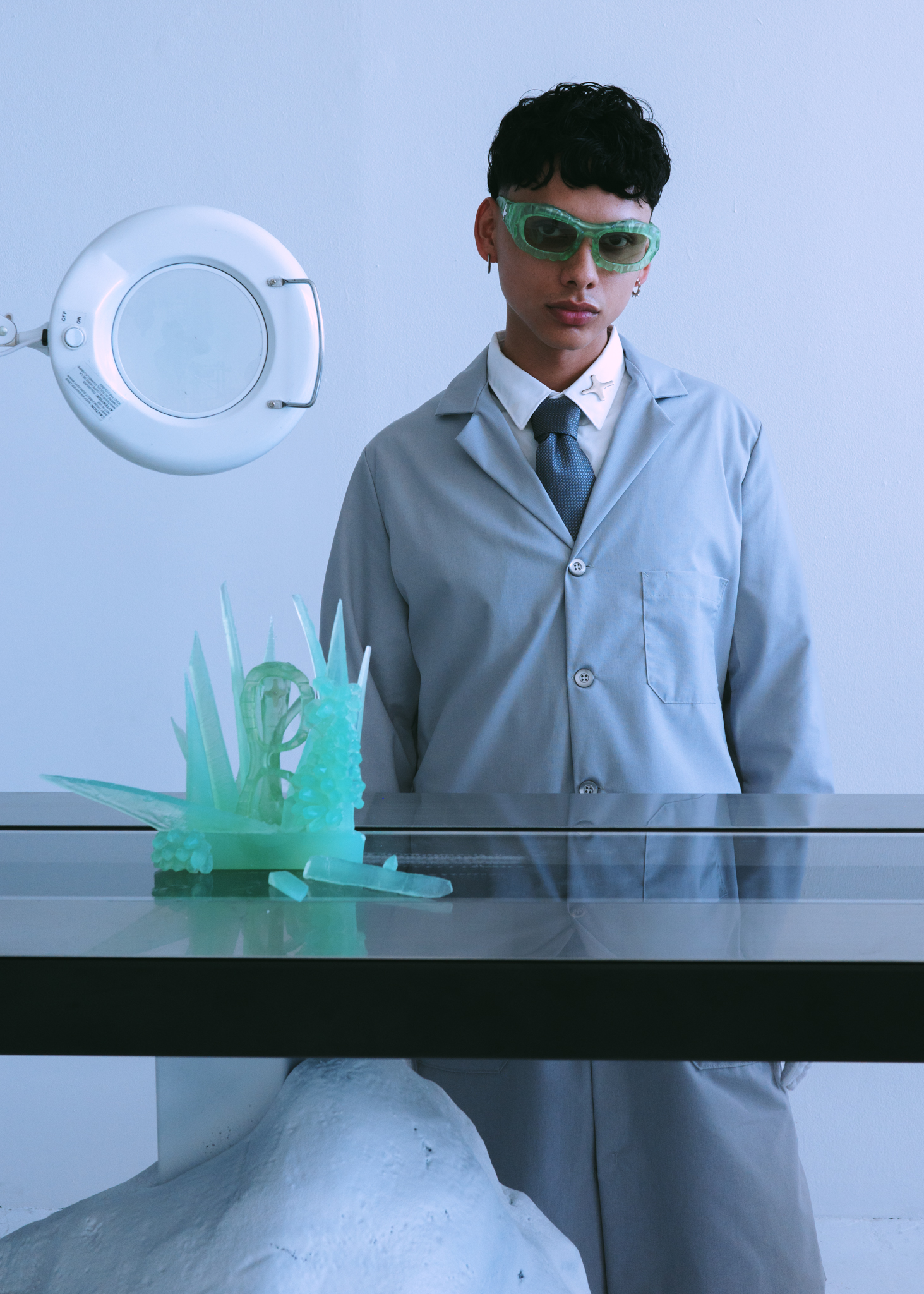

Cover design by Marta Lebek/Stocksy United.
Martha Friel, the protagonist of [Meg Mason’s](https://megmason.com) 2021 book [_Sorrow and Bliss_,](https://www.amazon.com/Sorrow-Bliss-Novel-Meg-Mason/dp/0063049589) has \_\_\_. Not a typo—Martha’s mental illness is multifaceted, results in many symptoms and outbursts, and Mason didn’t want it to take on one singular form. After the book’s end, a page says, “The medical symptoms described in the novel are not consistent with a genuine mental illness.”
Whatever Martha has, or the coagulation of many different ones, has been plaguing her since she was 17. She was forced to resign from college due to her longing to stay home all day, rocking underneath her father’s desk, and the book describes her journey to get the correct treatment. She’s been misdiagnosed, mistreated by her family and husband, and left to figure out her mind on her own. Her lifetime acquaintance turned husband remarks, “Sometimes I wonder if you actually like being like this.”
Martha struggles to find her way through life, navigating troublesome family gatherings at her aunt’s sprawling home, her troubles with Patrick as she lashes out over little things, and attempts to find a therapist that fits her. But when the therapist, Julie, says something about her ex-husband, Martha knows to drop her. “It’s like having a fat personal trainer,” she explains to Patrick. “It’s just, clearly you don’t understand what I’m trying to achieve.”
Martha’s life seems to be going downhill until she has a chance encounter with a friend’s doctor husband, Robert, who agrees to see her. Through just performing his job and doing simple acts of kindness like diagnosing her with the aforementioned \_\_\_, Martha immediately believes he’s the antidote to her troubles.
Though the story is depressing, Martha handles it all with a sharp wit and a keen eye, usually reflecting on herself with an insight so careful she seems outside of her body. The book is as funny as it is sad, and will have you recommending it to everyone you know (with a disclaimer to stock up on tissues).
_Flaunt_ sat down with Meg Mason to talk us through the novel.


Author photograph by Grant-Sparkes-Carroll.
**At the beginning of the book, we see Martha and Patrick’s marriage start to crumble, then it goes back and tells the story from the beginning, setting a kind of sad, knowing undertone for the book. What’s the effect of watching two people fall in love with the knowledge that eventually they’ll come apart?**
If in the first few pages I can make readers care about Martha and Patrick, portray them as a couple who the reader feels ought to be together, then knowing already that the relationship is going to come apart creates a driving force through the novel—the reader wants to know what it is that causes them to separate, and whether they will be able to overcome it.
**As a joke, while I was reading the book, I mentioned to my housemates while holding up the cover, “I’m still waiting for the ‘bliss’ to come.” Was there any time in writing it where you felt the same, or that it was too heavy?**
There wasn’t, but that’s because, while I was writing it, I never felt that dark passages were _that_ dark—which is odd since they empirically _are_, and I can see that now. But as the author you know from the beginning how Martha’s story will end, and that it will end well (if not happily in the straight-forward sense). Although, as is always the way, some readers find complicated female characters such as Martha ‘unlikeable’ I felt that underneath her illness, she is good, courageous, that she would overcome, and that in the meantime, she would deploy humor to mitigate that darkness, which is brave and generous in its own way.
**Martha is diagnosed with \_\_\_, a purposefully vague mental disorder that is the root of her problems. I restrained the want of immediately going to google, typing in her symptoms, and seeing what she has, but I didn’t and later realized the point was that it was a mess of emotions and feelings that was more about the whole of her person. Why did you go toward the direction of a blank disease rather than defining it?**
Because if, for example, it said in the first line of the blurb, ‘Martha is schizophrenia’ or ‘Martha has bipolar disorder,’ that is the only thing she would get to be—a mentally ill person with no other meaningful characteristics. We would view all of her actions, beliefs, and relationships through the lens of that illness, we would be inclined to check what we might know personally about that particular condition against what she does. As well, the central story is Martha’s quest for a diagnosis and if we had that knowledge before she did, we would ‘have it over her’. We would be the ones with the power and I wanted Martha to have all the agency and to be able to tell her own story.
Those were my concerns as an author—as a human being, I couldn’t bear the idea that I might portray a genuine condition inaccurately, and cause pain to readers for whom it is a real and present struggle. And of course, a mental illness doesn’t manifest identically in every sufferer so there was no possibility of my capturing it in a ‘universal’ way. As soon as I decided to redact it, it seemed strange I had ever thought to do otherwise.
**We see Martha enter this semi-parasocial relationship with Robert, the doctor who finally diagnoses her who she feels a special connection with. “I was consumed by the desire to know what Robert thought of me,” she says. How did Martha and Robert’s relationship come to be?**
Martha finds Robert by accident, well after she stopped seeking a diagnosis, having been treated poorly by so many practitioners in the twenty or so years since she first became ill, none who were ever able to determine, as she describes it what is ‘wrong’ with her. She meets Robert’s wife at a party, a woman she immediately warms to and when the woman mentions that her husband is a psychiatrist she says ‘I had not had a doctor for four years; I was not looking for one, but I made an appointment, I think because I wanted to see what kind of person he would be—if, being married to a woman like that meant he would be good. Therefore, unlike any doctor I had seen before.’ Thank goodness, he is, changing Martha’s life—she would say, saving it—by being the one to finally solve the mystery that has dogged her since she was seventeen.
**When Martha asks why no other doctor has diagnosed her with \_\_\_, Robert says, “I would say it’s because you’ve been managing it so well, for many years,” an affirming and important line for anyone who has gone through mental health struggles. Considering everything Martha has been through, this seems like the catalyst for her ultimately doing kind-of-well.**
I think it is true to say that most women have experienced inadequate medical care at one time in their lives, having their pain minimized by a practitioner, being branded hysterical, being made to feel unintelligent. Of course, medicine is an incredibly difficult job but at the same time, it takes so little to make a patient—especially women who have become used to medical misogyny—to feel validated. Robert tells Martha she has done well some time into their appointment but right from the beginning she sensed he was going to be different from any other she’d seen, just because he introduced himself by his first name, and ‘shook my hand, firmly, as though he hadn’t presumed it would be limp.’ It is such a small gesture, but it creates the kind of trust that means Martha can accept the difficult diagnosis he will deliver, but one that will change her life.
_Sorrow and Bliss_ is available now.
 
Cover design by Marta Lebek/Stocksy United.
Martha Friel, the protagonist of [Meg Mason’s](https://megmason.com) 2021 book [_Sorrow and Bliss_,](https://www.amazon.com/Sorrow-Bliss-Novel-Meg-Mason/dp/0063049589) has \_\_\_. Not a typo—Martha’s mental illness is multifaceted, results in many symptoms and outbursts, and Mason didn’t want it to take on one singular form. After the book’s end, a page says, “The medical symptoms described in the novel are not consistent with a genuine mental illness.”
Whatever Martha has, or the coagulation of many different ones, has been plaguing her since she was 17. She was forced to resign from college due to her longing to stay home all day, rocking underneath her father’s desk, and the book describes her journey to get the correct treatment. She’s been misdiagnosed, mistreated by her family and husband, and left to figure out her mind on her own. Her lifetime acquaintance turned husband remarks, “Sometimes I wonder if you actually like being like this.”
Martha struggles to find her way through life, navigating troublesome family gatherings at her aunt’s sprawling home, her troubles with Patrick as she lashes out over little things, and attempts to find a therapist that fits her. But when the therapist, Julie, says something about her ex-husband, Martha knows to drop her. “It’s like having a fat personal trainer,” she explains to Patrick. “It’s just, clearly you don’t understand what I’m trying to achieve.”
Martha’s life seems to be going downhill until she has a chance encounter with a friend’s doctor husband, Robert, who agrees to see her. Through just performing his job and doing simple acts of kindness like diagnosing her with the aforementioned \_\_\_, Martha immediately believes he’s the antidote to her troubles.
Though the story is depressing, Martha handles it all with a sharp wit and a keen eye, usually reflecting on herself with an insight so careful she seems outside of her body. The book is as funny as it is sad, and will have you recommending it to everyone you know (with a disclaimer to stock up on tissues).
_Flaunt_ sat down with Meg Mason to talk us through the novel.

Cover design by Marta Lebek/Stocksy United.
Martha Friel, the protagonist of [Meg Mason’s](https://megmason.com) 2021 book [_Sorrow and Bliss_,](https://www.amazon.com/Sorrow-Bliss-Novel-Meg-Mason/dp/0063049589) has \_\_\_. Not a typo—Martha’s mental illness is multifaceted, results in many symptoms and outbursts, and Mason didn’t want it to take on one singular form. After the book’s end, a page says, “The medical symptoms described in the novel are not consistent with a genuine mental illness.”
Whatever Martha has, or the coagulation of many different ones, has been plaguing her since she was 17. She was forced to resign from college due to her longing to stay home all day, rocking underneath her father’s desk, and the book describes her journey to get the correct treatment. She’s been misdiagnosed, mistreated by her family and husband, and left to figure out her mind on her own. Her lifetime acquaintance turned husband remarks, “Sometimes I wonder if you actually like being like this.”
Martha struggles to find her way through life, navigating troublesome family gatherings at her aunt’s sprawling home, her troubles with Patrick as she lashes out over little things, and attempts to find a therapist that fits her. But when the therapist, Julie, says something about her ex-husband, Martha knows to drop her. “It’s like having a fat personal trainer,” she explains to Patrick. “It’s just, clearly you don’t understand what I’m trying to achieve.”
Martha’s life seems to be going downhill until she has a chance encounter with a friend’s doctor husband, Robert, who agrees to see her. Through just performing his job and doing simple acts of kindness like diagnosing her with the aforementioned \_\_\_, Martha immediately believes he’s the antidote to her troubles.
Though the story is depressing, Martha handles it all with a sharp wit and a keen eye, usually reflecting on herself with an insight so careful she seems outside of her body. The book is as funny as it is sad, and will have you recommending it to everyone you know (with a disclaimer to stock up on tissues).
_Flaunt_ sat down with Meg Mason to talk us through the novel.
 
Author photograph by Grant-Sparkes-Carroll.
**At the beginning of the book, we see Martha and Patrick’s marriage start to crumble, then it goes back and tells the story from the beginning, setting a kind of sad, knowing undertone for the book. What’s the effect of watching two people fall in love with the knowledge that eventually they’ll come apart?**
If in the first few pages I can make readers care about Martha and Patrick, portray them as a couple who the reader feels ought to be together, then knowing already that the relationship is going to come apart creates a driving force through the novel—the reader wants to know what it is that causes them to separate, and whether they will be able to overcome it.
**As a joke, while I was reading the book, I mentioned to my housemates while holding up the cover, “I’m still waiting for the ‘bliss’ to come.” Was there any time in writing it where you felt the same, or that it was too heavy?**
There wasn’t, but that’s because, while I was writing it, I never felt that dark passages were _that_ dark—which is odd since they empirically _are_, and I can see that now. But as the author you know from the beginning how Martha’s story will end, and that it will end well (if not happily in the straight-forward sense). Although, as is always the way, some readers find complicated female characters such as Martha ‘unlikeable’ I felt that underneath her illness, she is good, courageous, that she would overcome, and that in the meantime, she would deploy humor to mitigate that darkness, which is brave and generous in its own way.
**Martha is diagnosed with \_\_\_, a purposefully vague mental disorder that is the root of her problems. I restrained the want of immediately going to google, typing in her symptoms, and seeing what she has, but I didn’t and later realized the point was that it was a mess of emotions and feelings that was more about the whole of her person. Why did you go toward the direction of a blank disease rather than defining it?**
Because if, for example, it said in the first line of the blurb, ‘Martha is schizophrenia’ or ‘Martha has bipolar disorder,’ that is the only thing she would get to be—a mentally ill person with no other meaningful characteristics. We would view all of her actions, beliefs, and relationships through the lens of that illness, we would be inclined to check what we might know personally about that particular condition against what she does. As well, the central story is Martha’s quest for a diagnosis and if we had that knowledge before she did, we would ‘have it over her’. We would be the ones with the power and I wanted Martha to have all the agency and to be able to tell her own story.
Those were my concerns as an author—as a human being, I couldn’t bear the idea that I might portray a genuine condition inaccurately, and cause pain to readers for whom it is a real and present struggle. And of course, a mental illness doesn’t manifest identically in every sufferer so there was no possibility of my capturing it in a ‘universal’ way. As soon as I decided to redact it, it seemed strange I had ever thought to do otherwise.
**We see Martha enter this semi-parasocial relationship with Robert, the doctor who finally diagnoses her who she feels a special connection with. “I was consumed by the desire to know what Robert thought of me,” she says. How did Martha and Robert’s relationship come to be?**
Martha finds Robert by accident, well after she stopped seeking a diagnosis, having been treated poorly by so many practitioners in the twenty or so years since she first became ill, none who were ever able to determine, as she describes it what is ‘wrong’ with her. She meets Robert’s wife at a party, a woman she immediately warms to and when the woman mentions that her husband is a psychiatrist she says ‘I had not had a doctor for four years; I was not looking for one, but I made an appointment, I think because I wanted to see what kind of person he would be—if, being married to a woman like that meant he would be good. Therefore, unlike any doctor I had seen before.’ Thank goodness, he is, changing Martha’s life—she would say, saving it—by being the one to finally solve the mystery that has dogged her since she was seventeen.
**When Martha asks why no other doctor has diagnosed her with \_\_\_, Robert says, “I would say it’s because you’ve been managing it so well, for many years,” an affirming and important line for anyone who has gone through mental health struggles. Considering everything Martha has been through, this seems like the catalyst for her ultimately doing kind-of-well.**
I think it is true to say that most women have experienced inadequate medical care at one time in their lives, having their pain minimized by a practitioner, being branded hysterical, being made to feel unintelligent. Of course, medicine is an incredibly difficult job but at the same time, it takes so little to make a patient—especially women who have become used to medical misogyny—to feel validated. Robert tells Martha she has done well some time into their appointment but right from the beginning she sensed he was going to be different from any other she’d seen, just because he introduced himself by his first name, and ‘shook my hand, firmly, as though he hadn’t presumed it would be limp.’ It is such a small gesture, but it creates the kind of trust that means Martha can accept the difficult diagnosis he will deliver, but one that will change her life.
_Sorrow and Bliss_ is available now.

Author photograph by Grant-Sparkes-Carroll.
**At the beginning of the book, we see Martha and Patrick’s marriage start to crumble, then it goes back and tells the story from the beginning, setting a kind of sad, knowing undertone for the book. What’s the effect of watching two people fall in love with the knowledge that eventually they’ll come apart?**
If in the first few pages I can make readers care about Martha and Patrick, portray them as a couple who the reader feels ought to be together, then knowing already that the relationship is going to come apart creates a driving force through the novel—the reader wants to know what it is that causes them to separate, and whether they will be able to overcome it.
**As a joke, while I was reading the book, I mentioned to my housemates while holding up the cover, “I’m still waiting for the ‘bliss’ to come.” Was there any time in writing it where you felt the same, or that it was too heavy?**
There wasn’t, but that’s because, while I was writing it, I never felt that dark passages were _that_ dark—which is odd since they empirically _are_, and I can see that now. But as the author you know from the beginning how Martha’s story will end, and that it will end well (if not happily in the straight-forward sense). Although, as is always the way, some readers find complicated female characters such as Martha ‘unlikeable’ I felt that underneath her illness, she is good, courageous, that she would overcome, and that in the meantime, she would deploy humor to mitigate that darkness, which is brave and generous in its own way.
**Martha is diagnosed with \_\_\_, a purposefully vague mental disorder that is the root of her problems. I restrained the want of immediately going to google, typing in her symptoms, and seeing what she has, but I didn’t and later realized the point was that it was a mess of emotions and feelings that was more about the whole of her person. Why did you go toward the direction of a blank disease rather than defining it?**
Because if, for example, it said in the first line of the blurb, ‘Martha is schizophrenia’ or ‘Martha has bipolar disorder,’ that is the only thing she would get to be—a mentally ill person with no other meaningful characteristics. We would view all of her actions, beliefs, and relationships through the lens of that illness, we would be inclined to check what we might know personally about that particular condition against what she does. As well, the central story is Martha’s quest for a diagnosis and if we had that knowledge before she did, we would ‘have it over her’. We would be the ones with the power and I wanted Martha to have all the agency and to be able to tell her own story.
Those were my concerns as an author—as a human being, I couldn’t bear the idea that I might portray a genuine condition inaccurately, and cause pain to readers for whom it is a real and present struggle. And of course, a mental illness doesn’t manifest identically in every sufferer so there was no possibility of my capturing it in a ‘universal’ way. As soon as I decided to redact it, it seemed strange I had ever thought to do otherwise.
**We see Martha enter this semi-parasocial relationship with Robert, the doctor who finally diagnoses her who she feels a special connection with. “I was consumed by the desire to know what Robert thought of me,” she says. How did Martha and Robert’s relationship come to be?**
Martha finds Robert by accident, well after she stopped seeking a diagnosis, having been treated poorly by so many practitioners in the twenty or so years since she first became ill, none who were ever able to determine, as she describes it what is ‘wrong’ with her. She meets Robert’s wife at a party, a woman she immediately warms to and when the woman mentions that her husband is a psychiatrist she says ‘I had not had a doctor for four years; I was not looking for one, but I made an appointment, I think because I wanted to see what kind of person he would be—if, being married to a woman like that meant he would be good. Therefore, unlike any doctor I had seen before.’ Thank goodness, he is, changing Martha’s life—she would say, saving it—by being the one to finally solve the mystery that has dogged her since she was seventeen.
**When Martha asks why no other doctor has diagnosed her with \_\_\_, Robert says, “I would say it’s because you’ve been managing it so well, for many years,” an affirming and important line for anyone who has gone through mental health struggles. Considering everything Martha has been through, this seems like the catalyst for her ultimately doing kind-of-well.**
I think it is true to say that most women have experienced inadequate medical care at one time in their lives, having their pain minimized by a practitioner, being branded hysterical, being made to feel unintelligent. Of course, medicine is an incredibly difficult job but at the same time, it takes so little to make a patient—especially women who have become used to medical misogyny—to feel validated. Robert tells Martha she has done well some time into their appointment but right from the beginning she sensed he was going to be different from any other she’d seen, just because he introduced himself by his first name, and ‘shook my hand, firmly, as though he hadn’t presumed it would be limp.’ It is such a small gesture, but it creates the kind of trust that means Martha can accept the difficult diagnosis he will deliver, but one that will change her life.
_Sorrow and Bliss_ is available now.









.JPG)
.jpg)







